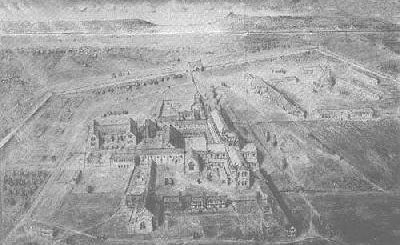Salem Village Parsonage (1692)
Salem Village (now Danvers) was settled by European farmers from nearby Salem Town in the 1630’s becoming a separate parish in 1672. The Parsonage dated from 1681, and from 1689 when the covenant church was established it was the home of English born Rev Samuel Parris (born 1653 – died 27 February 1720), his family and household slaves. Having emigrated to America with his family in 1660, Parris was a fanatical Puritan with a terrible temper and he has to take some responsibility for the events that occurred after preaching about how the Devil was active within the Parish.
In either January or February 1692 an event happened at the parsonage of Reverend Samuel Parris that was to spark off the events known as the Salem Witch Trials which resulted in 20 innocent people being executed (19 hanged, 1 pressed to death) and around 150 being imprisoned. It all started with two young girls practising an old English folk tradition.
The girls were Elizabeth “Betty” Paris, aged 9 (born 28 November 1682 – died 21 March 1760), the daughter of Rev Parris and his niece, Abigail Williams, aged 12 (12 July 1680). One night, in secret, knowing that Rev Parris would disapprove they played with an old English folk tradition to try and identify who their future husbands would be. This form of divination required an egg to be cracked in a glass of water and the white of the egg was supposed form into a shape that would identify the profession of their true love. It was just two young girls that had been brought up in a strictly religious community having some forbidden fun, which all went wrong.
In the Puritan colonies life was not that easy. Aside from the constant threat of attack from Native American Indians, the strict religious beliefs of the settlement elders forbid fun and entertaining things like singing and dancing. It is thought that this caused anxiety and boredom. It is hardly surprising given her very young age and the environment that she was raised in, by a fanatical Puritan, that when Betty saw the egg white form a shape resembling a coffin she was greatly disturbed. She saw it as evidence of the supernatural and racked with terror, guilt and anxiety she had a hysterical fit. Abigail also showed signs of hysteria though it has been speculated that this may have passed onto her from the younger Betty.
The girls continued to have their fits and found they were actually struggling to talk, which of course concerned their parents. The mass hysteria was soon to spread further to other girls living close by, Elizabeth Hubbard (age 17) and Ann Putnam (age 12). It has been suggested that the hysteria may have been spread by the anxiety of the environment, but it may also have been the relief it brought to the general boredom and the attention it brought to the girls that they continued to have the fits. In many cases it was just play acting.
The medical opinion of Dr William Griggs (uncle and guardian of Elizabeth Hubbard) was that the girls were victims of “an evil hand” (witchcraft). Rev Parris questioned the girls, intent upon finding who was ‘afflicting them’ and they initially named three women, people on the outskirts of the community, Sarah Good, Sarah Osborne and Rev Parris’s Native American slave, Tituba.
On 29th February 1692, Thomas Putnam (father of the afflicted Ann Putnam) and Edward Putnam complained to the magistrates in Salem and the witch trials began.
Sarah Good (born in Wenham 1653) was impoverished and begged with her husband William Good in and around the parish. Considered by the community as being an unsavoury individual she was an easy target for accusations. Even though she never confessed, she was hanged as a witch on 19 July 1692. (Hanging was the English penalty for executing witches and the Puritans had brought the English legal system over with them when them emigrated). Sarah had been sent to jail with a young baby, which died in the cell and her 4 (or 6) year daughter Dorcas was also imprisoned for 8 months.
Sarah Osborne (Osburn) was the widow of Robert Prince who owned a farm neighbouring John Putnam. When Prince died his estate was to carry over to his two young sons but Sarah and her new Irish husband Alexander Osborne attempted to take control of the farm land, thus upsetting the general community and especially Putnam who was a friend of Robert Prince. Little wonder that when the Putnam’s made their complaint she was one of the accused. Even though she professed her innocence, the girls would have fits whenever she looked in their direction. She died on 10 May 1692 in prison.
Tituba was the Native American slave of Samuel Parris. Under relentless questioning and the twisting of her answers she actually started to confess and implicated both Sarah Good and Sarah Osborne, accusing them of witchcraft. She spent 13 months in jail before somebody paid for the cost of her imprisonment and she was released. She did not return to Salem.
With the confession of Tituba the witch trials were seen as being validated and other accused witches trying to gain leniency confessed and accused others, resulting in a huge travesty of justice and loss of live.
“Clear evidence of outright deception at the trials can be found in a number of sources. It seems likely that the girls’ behaviour was a complicated mixture of the involuntary and the voluntary, the innocent and the corrupt, varying from one girl to another and one incident to another.” – Frances Hill, Hunting the Witches (2002).
The parsonage was demolished in 1784 but the excavated foundations are preserved and can be visited.





Re: Salem Village Parsonage (1692)
Recommended film: ‘Three Sovereigns For Sarah’ , if you can find it, with Vanessa Redgrave…fascinating reading, as always…